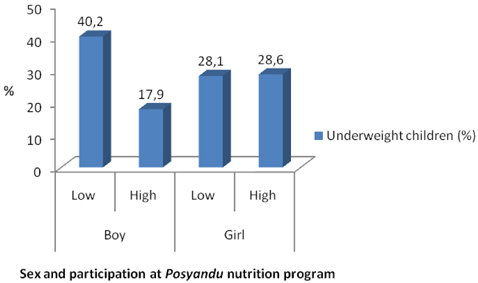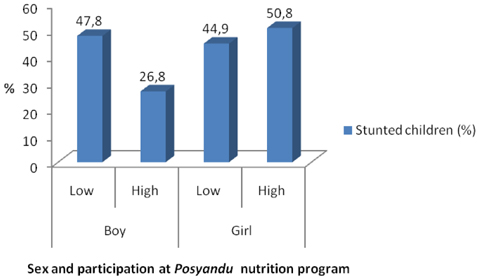Nutr Res Pract.
2010 Jun;4(3):208-214.
High participation in the Posyandu nutrition program improved children nutritional status
- Affiliations
-
- 1Department of Community Nutrition, Faculty of Human Ecology Bogor Agricultural University, Darmaga, Bogor 16680, Indonesia. faisalanwar_gmipb@yahoo.com
Abstract
- The objective of this research was to analyze nutritional status and food consumption of children participating in the Posyandu nutrition program. A total sample of 300 children under five years had been drawn. Sample was divided into two categories namely high participation and low participation in the Posyandu nutrition program. The sample was selected from two sub districts of Cianjur District, West Java. The districts were areas with a high proportion of poor people and many of them take the benefits of Posyandu nutrition program conducted by the government. The participation of children (under five years old) in visiting Posyandus was relatively good, namely, 92.4% (for the high participation group). However, for the low participation group, the number of participating children was relatively low (28.3%). The average consumption of energy for children under five years old was still below the recommended dietary allowance < 80% of RDA, whereas the protein consumption was already above the RDA. The prevalence of underweight, stunting, and wasting among children were respectively 30.0%, 43.7%, and 12.3%. The activities at Posyandus had a positive impact on the nutritional status of children under five years olds, measured in terms of weight for age (W/A) and weight for height (W/H). The more frequent the visit to Posyandus, the better the nutritional statuses would be.
Figure
Reference
-
1. Azwar A. Aspects of health and nutrition in food security. 2004. In : National Workshop on Food and Nutrition 2004; Jakarta: LIPI (Indonesian Institute of Science).2. United Nations Development Programme. Sub-Committee on Nutrition at its 24th Session. 1997. In : Meeting the Nutrition Challenge: A Call to Arms; New York, USA.3. Hartoyo , Astuti D, Briawan D, Setiawan B. Supplemental Feeding to Children Under Five Years Old and Empowerment of Families/Community in Bogor Municipality. 2000. Bogor: Department of Community Nutrition and Family Resources, IPB.4. WHO. Global Database on Child Growth and Malnutrition. 1997. Geneva: WHO.5. UNICEF Tulane University and the Micronutrient Initiative. Progress in Controlling Vitamin A Deficiency. 1997. New Orleans, LA: Tulane University, Micronutrient Initiative Draft Report.6. WHO. WHO Child Growth Standards: Length/Height-for-Age, Weight-for-Age, Weight-for-Length, Weight-for-Height and Body Mass Index-for-Age: Methods and Development. 2006. Geneva: WHO.7. Central Bureau of Statistics. Indicators of People's Welfare. 2000. Jakarta, Indonesia: Indonesian Central Bureau of Statistics.8. Sukarni M. Health, Family, Environment. 1994. Yogyakarta, Indonesia: Kanisius.9. Central Bureau of Statistics. Statistics of People's Welfare. 1996. Jakarta, Indonesia: Indonesian Central Bureau of Statistics.10. Pranadji DK. Food Consumption Behaviour of Households as Members of Nutrition Park. 1988. Bogor, Indonesia: Faculty of Postgraduate Studies, Bogor Agricultural University (IPB);Master Thesis.11. Central Bureau of Statistics. Statistics of Indonesian Data. 2007. Jakarta, Indonesia: Indonesian Central Bureau of Statistics.12. Irawan PB, Romdiati H. Impact of Economic Crisis towards Poverty and Their Implications for Building Strategy in Indonesia. 2003. In : Paper of 7th National Workshop on Food and Nutrition; Jakarta, Indonesia: Indonesian Institute of Sciences.13. Darmawati I. Performance of Posyandu in Pandeglang. Department of Community Nutrition and Family Resources, Faculty of Agriculture. 2001. Bogor, Indonesia: Bogor Agricultural University.14. Rahmawati Y. Faculty of Postgraduate Studies. Applied Analysis of Economic Function, Socialization Function, and Education on Poor Households in Rural and Urban Area on Crisis Period. 1999. Bogor, Indonesia: Bogor Agricultural University;Master Thesis.15. Ministry of Health, Republic of Indonesia. National report of research result on basic health (Laporan Nasional Hasil Riset Kesehatan Dasar) 2007. 2008. Jakarta: Board of Health Research and Development, Ministry of Health, Indonesia.16. Central Bureau of Statistics. Susenas (National Survey of Social Economy) Year 2005. 2006. Jakarta, Indonesia: Indonesian Central Bureau of Statistics.17. WHO. EB101/8. Health for All in the 21st Century. 1998. Geneva: WHO.
- Full Text Links
- Actions
-
Cited
- CITED
-
- Close
- Share
- Similar articles
-
- The Effect of NutriPlus Program among 1-5 Year Children in Daejeon Area - The Improvement in Nutritional Status of Children and Nutrition Knowledge and Attitude of Parents -
- Changes in health status of North Korean children and emerging health challenges of North Korean refugee children
- Evaluations of the Elderly Nutrition Improvement Program in the community health center: Effects of nutrition counseling and education program on elderly dietary behavior
- Nutritional Risk of the Elderly Receiving a Home-Delivered Meal Service Program and the Factors for Nutritional Risk
- Relationship between nutritional status, psychosocial stimulation, and cognitive development in preschool children in Indonesia




